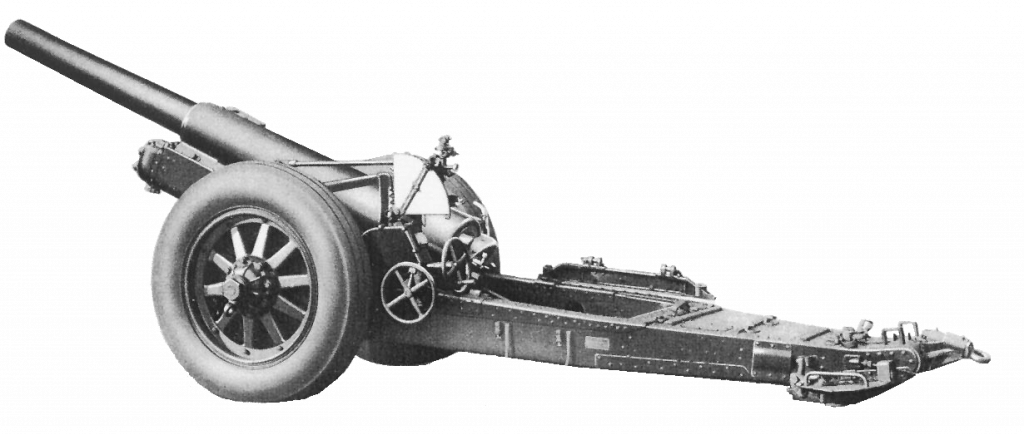
The 7.2 inch Howitzer was developed from the 8 inch Howitzer. In July 1940 there was a severe shortage of heavy artillery and a demand was raised for a new gun of about 8 inch calibre with greater range than the existing 8 inch Howitzer. It also needed to be on the same sort of carriage as the 8 inch Howitzer. In August 1940, trials were carried out to determine how much stress the carriage and recoil system of the 8 inch could stand. As a result, development was started on a 7.2 inch Howitzer firing a 200 lb shell with a maximum muzzle velocity of 1,700 feet per second.
Existing 8 inch Howitzers were taken to workshops where the barrel liner was removed and replaced with a 7.2 inch liner. Alterations were made to the breech mechanisms to suit the new calibre. This new weapon was then introduced as the 7.2 inch Howitzer Mark 1. It was officially approved on the 7th April 1941. A little later, American 8 inch Howitzers were bought and converted to 7.2 inch in the same way.
There was a problem with the recoil as the force was more than the recoil system could absorb fully. As a result the carriage moved backwards on firing and on wet ground this movement could be unpredictable and dangerous with the crew having to stand well clear of the gun before firing. To try and control this movement, large wedges were placed behind the wheels so that on recoiling the gun ran up the slope of the wedge and back down again. Even with these wedges, firing was still daunting for the crew. Early in 1943 it was decided that with Charge 4 the gun was not fully under control and so a search began for a new carriage.
The American 155 mm Gun M1 started to arrive in the UK. Its carriage could be adjusted to take the US 8 inch Howitzer so in April 1943 a trial fitting was made of the 7.2 inch. It was successful and the combination was approved in November 1943 as the 7.2 inch Howitzer Mark 5. At the same time a new, more powerful howitzer was being prepared. A completely new design, 33 calibres long, it was approved and adopted on the 21st December 1943 as the Mark 6 Howitzer. As a result the Mark 5 was never issued for service.

The Mark 6 increased the maximum range by about two miles and became the standard equipment of Heavy Regiments. It remained in service into the 1960’s.
Data
The following values have been converted into metric measurements from the original sources, which used imperial measurements, unless otherwise stated.
7.2in Howitzer Mk1 to Mk4
| Calibre | 182.9mm (7.2in) |
| Weight of Gun & Breech Mechanism | 3.66tons |
| Weight in Action | 10.3tons |
| Total Length | 4.34m |
| Rifling | 40 grooves, uniform right hand 1/20 |
| Breech mechanism | Asbury interrupted screw, percussion lock ‘K’ and slide box ‘Y’ |
| Elevation | 0° to +45° (loading angle 7½°) |
| Traverse | 4° right and left |
| Recoil System | Hydro-pneumatic, variable, 24in to 52in |
7.2in Howitzer Mk6
| Calibre | 182.9mm (7.2in) |
| Weight of Gun & Breech Mechanism | 5.03tons |
| Weight in Action | 14.53tons |
| Total Length | 6.29m |
| Rifling | 40 grooves, uniform right hand 1/20 |
| Breech mechanism | Asbury interrupted screw, percussion lock ‘K’ and slide box ‘Y’ |
| Elevation | -1°50′ to +63° |
| Traverse | 30° right and left |
| Recoil System | Hydro-pneumatic, variable, 36in to 60in |
Performance
7.2in Howitzer Mk1 to Mk4
These values are based upon the weapon firing a standard 90.7kg HE Shell (reference Ammunition).
The 7.2inch Howitzer Mk1 to Mk4 used four charges, from Charge 1 up to Charge 4.
| Charge 1 | 2kg with 0.22kg of Cordite |
| Charge 2 | 3.17kg with 0.08kg of Cordite |
| Charge 2 | 7.71kg with no Cordite |
| Charge 2 | 8.6kg with 0.34kg of Cordite |
Using a different number of charges gave the weapon varied performance.
| Muzzle Velocity | 274.3 to 518.1 metres/second |
| Range | 6.85km to 15.45km |
7.2in Howitzer Mk6
These values are based upon the weapon firing a standard 90.7kg HE Shell (reference Ammunition).
The 7.2inch Howitzer Mk6 used a single charge called Charge 5, which weighed 14.06kg. This single charge replaced the four-piece charge for the newer platforms but it could not be used with the Mk1 to Mk4 Howitzers.
| Muzzle Velocity | 586.74 metres/second |
| Range | 17.92km |
Ammunition
Shell, HE, Mk1D
This shell was streamlined, fitted with a plug in its nose and filled with Amatol 50/50. The plug in the nose was removed before firing, with a variation of fuses being available for the weapon over its lifecycle. Despite the length of the howitzers service, no time or proximity fuses were ever made specific to the 7.2inch barrel.
The only alternative shell was the Shell HE Mk2D, which was essentially the same as the Mk1D and even achieved the same range.
| Total Weight | 90.7kg |
| Weight of TNT | Not known |
| Fuse Types | Percussion DA No.117 / Percussion DA and Graze No.119 / Percussion Graze No.231 |
Page last updated 08/11/25.
